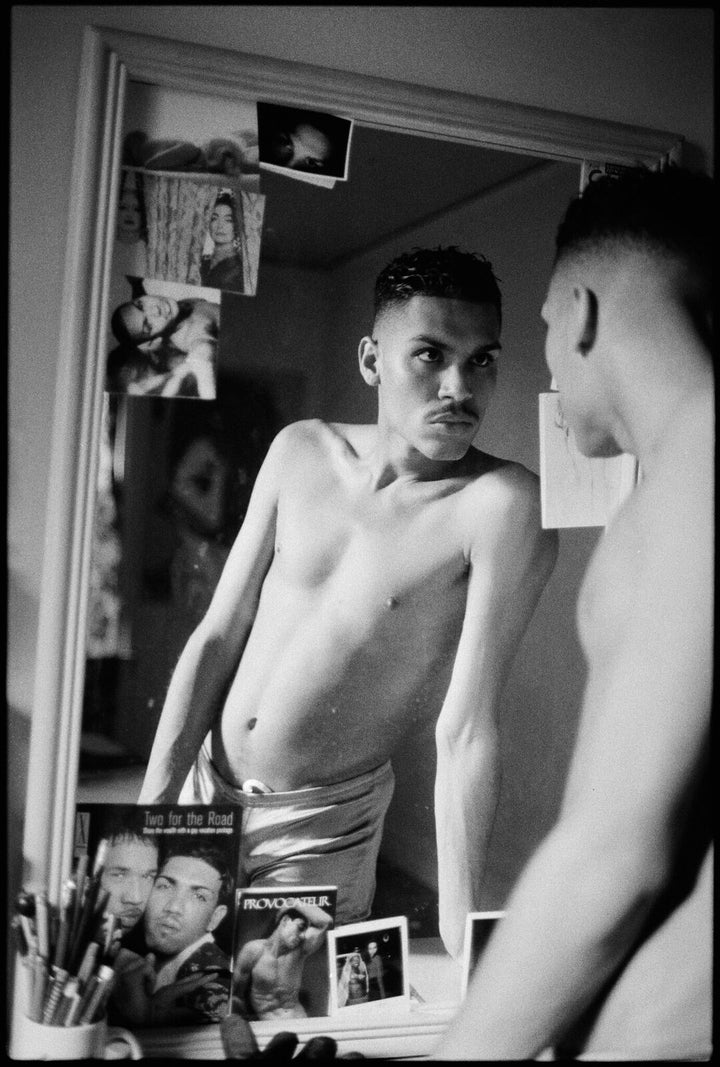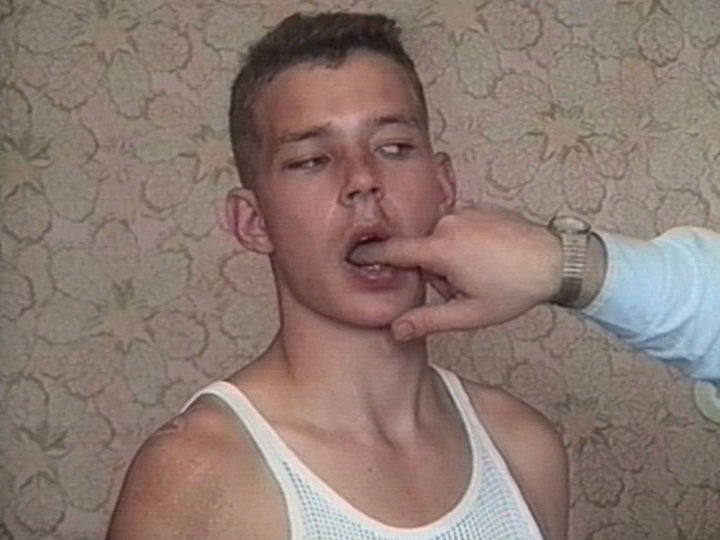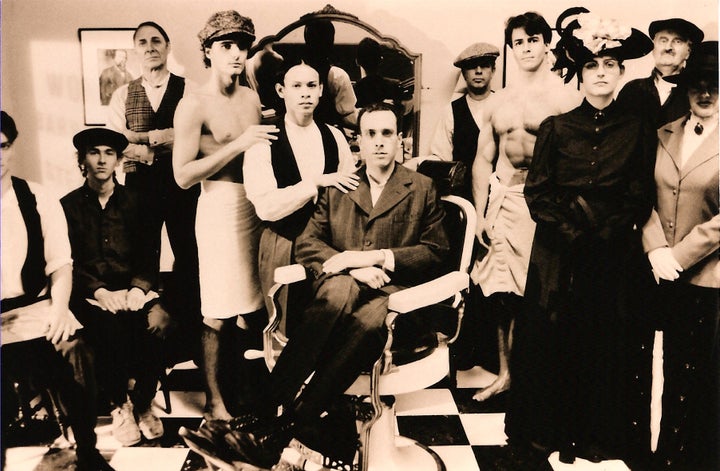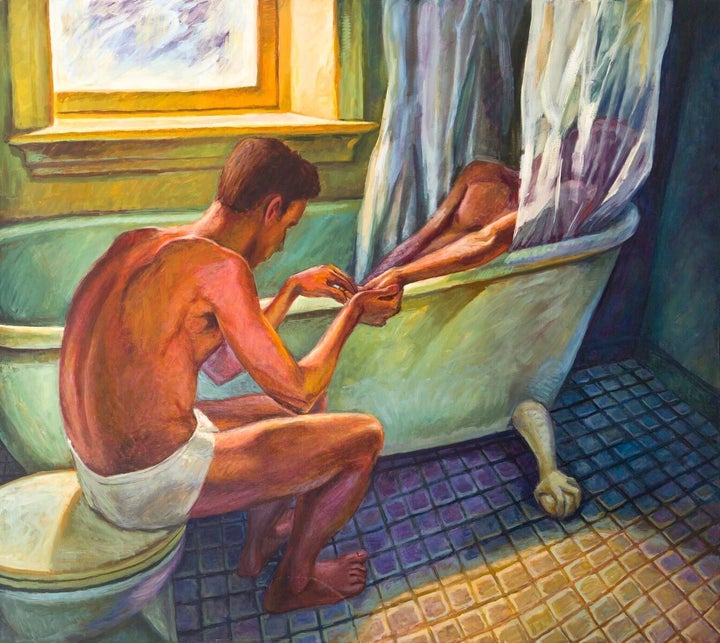
From “AIDS at Home”: Luna Luis Ortiz, “Reality Sets In,” a self-portrait, 1996.
I’ve just had the opportunity to see two compelling shows that present the question: What holds human beings, especially what we now call “queer” human beings, together? What drives us to find each other, love each other, and work toward a goal that may not even be possible, but cannot easily be ignored?
The first was “The Work of Love, the Queer of Labor,” co-curated by painter and conceptual artist Yevgeniy Fiks and Olga Kopenkina at Franklin Street Works, 41 Franklin Street in Stamford, CT, closing on August 27; and the second “AIDS at Home: Art and Everyday Activism,” curated by Stephen Vider, at the Museum of the City of New York, closing on October 22.
Christopher Isherwood in his memoir Christopher and His Kind said that he had a hunger to be united with his own “kind,” meaning other gay men. This hunger, in a time of extreme homophobia, was barely voiced but undeniable. “The Work of Love, the Queer of Labor” verifies this. It is often a serious show, but there are moments of humor, irony and downright craziness. It starts off with a question: “Is queer liberation a class struggle?”
The answer depends on your idea of class and what comprises it. Is class simply about economic level—privilege versus hardship?—or is it about a boundary of feelings that people fit into naturally once those feelings (or attractions) are felt and recognized? Having the feelings recognized has been the hardest problem, historically, for most within the lgbtq family. For centuries these feelings have been ignored, outlawed, held in contempt, and severely punished from the Right and the Left. However, there have been pockets of openness, often on the Left, and the Labor Movement has at various points been a haven of these. What “Work/Queer” examines often is class and how it is negotiated in an underground queer environment shot through with desire, as in Montague Glover’s pictures of working class men in 1930s England A Class Apart, or William Jones’s deadpan video “The Fall of Communism as Seen in Gay Pornography” which gives a totally serious slant to the pornography of Eastern European “captive nations” prior to the end of the USSR.

William E. Jones, "The Fall of Communism as Seen in Gay Pornography," 1998 (Single channel video)
A lot of this show is conceptual, presenting ideas in small environments of their own, like Estonian artist Jaanus Samma’s “Not Suitable for Work, A Chairman’s Tale,” that uses a desk, chair, and lamp to peruse a book detailing the life of Juhan Ojaste (1921-90) a successful member of Estonia’s Communist Party accused of sodomy and sentenced to one and a half years of hard labor, thereby losing everything in the process. There is also a video that goes with this piece.

Noam Gonick "1919," 1997, 35 mm film transferred to digital
Another video, Noam Gonick’s “1919,” from 1997 is an 8-minute avalanche of craziness, pathos, and genuine beauty, dealing with a worker insurrection, the Winnipeg General Strike of 1919, the most famous and remembered strike in Canadian history. “1919” shoots the cannonball of the class struggle into a Chinese gay-patronized barbershop and bathhouse that during the strike was commandeered as a communist refuge. It is really one of the highlights of this show, but there are others, including Angela Beallor’s gloss on “I Want A Baby,” a Russian play from the first decade after the Revolution that was first censored by the Bolsheviks, then valorized for its rejection of bourgeois sexual values.
I was new to Franklin Street Works, but this oasis of humanity in what has become faceless corporatized Stamford is worth a detour. It also has an excellent café that offers food and drink, as well as a back outdoor space.
“AIDS at Home: Art and Everyday Activism” at the Museum of the City of New York is really a spectacular, ambitious show, using the full resources of the Museum to advantage. It includes paintings, drawings, multimedia work, court documents, videos, interviews, even clinical information. It focuses on the heroic period of AIDS activism, basically from the first recognition of the AIDS problem in the early 1980s, to about 1996, when the HIV “cocktail” appeared, and AIDS became, for a lot of people, a “treatable” disease, although as Ted Kerr, one of three voices in a video (“Living in the City, Three Stories about HIV AIDS”—the others are Wanda Hernandez Park and Kia LaBeija), who has become an “HIV doula,” a dedicated caretaker, observes: “The public AIDS community” has been replaced by the “private AIDS experience,” marked by the professionalization of the disease, doctors, and private health care systems.

Hugh Steers, “Bath Curtain,” oil on canvas, 1992
There are some big and recognizable names in this show—David Wojnarowicz and Nan Goldin—and artists I know and have written about like Eric Rhein. But the refreshing thing is the use of unusual forms, like L. J. Roberts’s (b. 1980) use of fine embroidery to create pictures of mostly unsung AIDS activists, and Luna Luis Ortiz’s (b. 1972) snap-shot-intense street photography of kids who hung out in the West Village in the early 1990s. Ortiz was infected with HIV at the age of 14, and took up photography soon after. A very candid video from 1993 by Juanita Mohammed Szczepanski (b. 1957) captures Ray and Tyrone, two men of color who want to adopt the HIV-positive son of Ray’s sister. There’s the quirkiness of Michael Slocum’s (1956-1995) cartoon strip,“Zandre Alexander,” that he ran in Newsline, published by the People with AIDS Coalition. Kia LaBeija (b. 1990) was born HIV-positive; her mother was Kwan Bennett, an advocate for people usually overlooked in the crisis, Native Americans and Asians. Kwan was a straight woman of Asian and Native American descent who died of the disease, and Kia’s video about her keeps her name alive.
There are so many words and voices in this beautiful show, curated by Stephen Vider, a young curator, but two really hung with me: Ted Kerr saying, “We have medicines to treat the virus, but not to deal with the stigma.” This is still so true. And Wands Hernandez Park saying, “Housing is healthcare.” In New York, as we learn over and over again, housing has become the last word for too many people.
Award-winning writer and gender-rights pioneer, Perry Brass has published 19 books, including poetry, novels, short fiction, science fiction, and bestselling advice books (How to Survive Your Own Gay Life, The Manly Art of Seduction, The Manly Pursuit of Desire and Love). A member of New York’s radical Gay Liberation Front, in 1972, with two friends, he co-founded the Gay Men’s Health Project Clinic, the first clinic specifically for gay men on the East Coast, that is still operating as the Callen-Lorde Community Health Center. His acclaimed and often censored dystopian futurist novel Carnal Sacraments has recently been translated into Italian and Spanish, and shows that Donald Trump is only the “gateway” schmuck for what’s coming up next.
